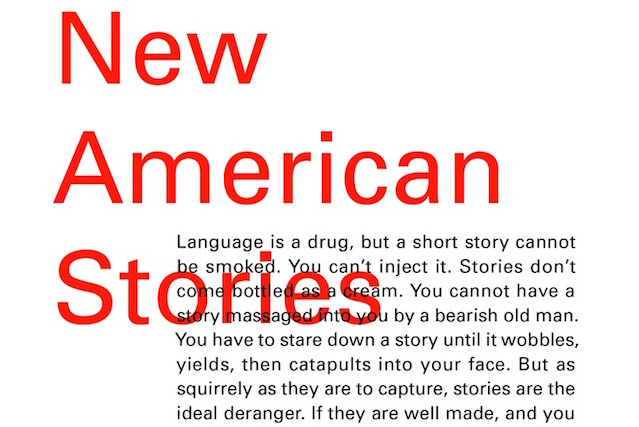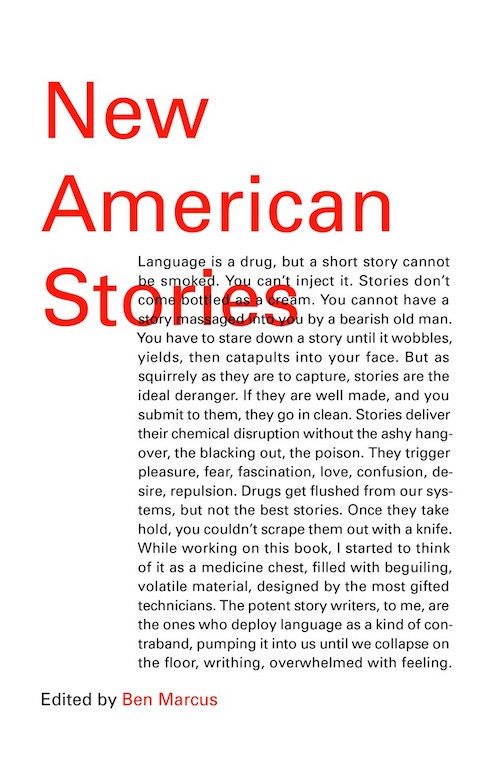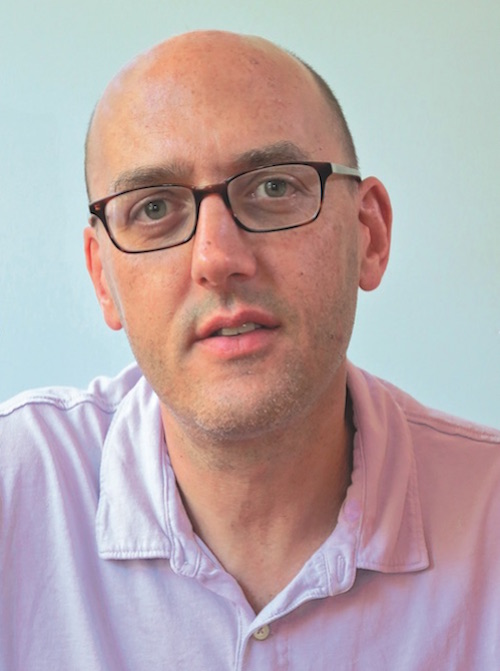By Joel Breuklander
If a nationwide literary ration were instituted tomorrow and you were told you could have only one single, solitary book of contemporary short stories, you should spend your allotment on The Anchor Book of New American Short Stories, a 2004 anthology edited by Ben Marcus. It’s the only book whose cover I’ve worn off from over-reading, a kaleidoscopic collection that wonderfully encapsulated the variety and power of American short fiction, its range of voices and styles, the cross-pollination of genres and the boundless forms, both shocking and classic.
If the ration is increased to two, however, you should head straight for New American Stories, a decade-later spiritual sequel to Marcus’s earlier anthology. It’s a treasury and a who’s who of literary fiction, ideal company for any lover of the form. The breadth of subjects and moods includes DeLillo writing presciently about the Eurozone and Greece in crisis to the wry humor and desperate narrators of Joy Williams and Rivka Galchen to unusual, exciting stories by several less well-known authors. The result is a bird’s-eye view into the state of American short fiction over the last decade, the concerns of our authors, and—through contrast with Marcus’s last edited collection—an intriguing look at how the field may be changing.
Only a handful of the authors are repeats from the 2004 anthology. The Anchor Book introduced many readers to George Saunders, who’s gone on to become a critical darling with his collection Tenth of December; that collection contributes a gutpunch of a story, “Home,” to the offerings here. Christine Schutt and Anthony Doerr appear again, too—since The Anchor Book, the former was nominated for a Pulitzer and the latter won one. Marcus is himself a compelling argument in favor of content curation, spotting authors like these and helping to canonize masters like Lydia Davis and David Foster Wallace. His track record and the sheer quality of this newer batch of fiction means that you’re sure to hear names like Charles Yu, Saïd Sayrafiezadeh, and Kelly Link more and more often, and that Donald Antrim and Deborah Eisenberg, among others, have been anointed modern masters.
Throughout New American Stories there’s a level of political and social awareness often absent from the 2004 anthology. Mary Gaitskill, Saïd Sayrafiezadeh, and Zadie Smith all deal with our changed relationship with war, the security state, and nationalism; they describe strained and porous divisions between civilian and military life, and the bizarreness of normalcy in a world where armed violence doesn’t cease so much as move from place to place. Many of the stories share a heightened anxiety about the ramifications of rapid technological change as well. Characters are deposited in versions of China, England, or Los Angeles with shades of the dystopian, seeming to borrow from popular fiction and film a notion that near-future science fiction settings offer a compromise between realism and the fantastic. A greater socio-political awareness seems to affect the book on a macro editorial level, too: more than half of the stories—seventeen of thirty-two—are by women (Hello, VIDA!) and there are several more writers of color present than there were in The Anchor Book.
It shouldn’t be a surprise that it’s the experimental stories that seem most different from those collected a decade ago—why wouldn’t fiction at its innovative margins be more volatile?
The stories in this newest collection are generally more narrative driven and accessible; fewer are ultra short, with stories averaging about twenty-three pages to The Anchor Book’s sixteen. One of the starkest differences in the stories is seen in the handful of experimental pieces. While the innovations of the last collection focused on language—Gary Lutz’s convolutions of grammar, the poetic turns of Anne Carson, Joe Wenderoth, and Dawn Raffel—the most innovative stories here play with frames and scale. There’s Rachel Glaser’s “Pee on Water,” which careens back and forth at high speed between magnified images of the personal or domestic and a kind of scattershot history of humankind. In Robert Coover’s spectacular “Going for a Beer,” the whole of a man’s life slips past him over the course of a few pages, almost unnoticed. There is a heaping helping of the unnerving, too, in the anatomy-class violence of Kyle Coma-Thompson’s, “The Lucky Body” or Mathias Svalina’s descriptions of imagined, frightening children’s games, not to mention Jesse Ball’s, “The Early Deaths of Lubeck, Brennan, Harp, and Carr” with its combination of violence, surrealism, confusion, and Kafka-like inevitability.
Some of the excellent voice-driven work in New American Stories, like Saunder’s real-feeling, earnest idiots or Tao Lin’s deadpan millenialisms, feels less shockingly experimental today than it might have a decade ago, no doubt by virtue of its success. If this new collection is lacking anything, though, it may be a few short, swift pieces from a poetic background. Lyrical, roomy, poignant pieces by Carson and Wenderoth allowed The Anchor Book to breathe; the absence of something similar this time around may reflect changing aesthetic ideals.
It shouldn’t be a surprise that it’s the experimental stories that seem most different from those collected a decade ago—why wouldn’t fiction at its innovative margins be more volatile? But Marcus himself would prefer that the word experimental wasn’t used. He’s been called the “vanguard” of experimental fiction and its “unabashed apologist,” thanks to his own challenging, inventive early fiction and to his “spirited defense of experimental fiction,” as the New York Times put it, in a 2005 Harper’s essay combatively titled “Why experimental fiction threatens to destroy publishing, Jonathan Franzen, and life as we know it.” But Marcus has done his best to keep the label “experimental” at arm’s length. In his introduction to New American Stories he explicitly says that he is against genre labels: “[R]ealist and experimentalist… [are]… minor labels that… scar our writers… someone else’s nicknames… lie[s].”
Is there any reason to call fiction experimental? Perhaps the comparison to questing into the unknown, the implication that experiments can fail or turn up surprising results, could be found attractive.
This is only the latest volley in a battle Marcus has been fighting for some time. In that Harper’s essay on experimental fiction he abandoned the term as a slur while embracing authors who had been so labeled. “Calling a writer experimental,” he wrote, “is now the equivalent of saying his work does not matter, is not readable, is aggressively masturbatory…. [A] writer with ambition now is called ‘postmodern’ or ‘experimental,’ and not without condescension.” Where he used the word experimental Marcus often preceded it with “so-called.” And when an interviewer at HTMLGIANT brought the word up a few years back, Marcus reacted sharply, “This issue… is hollow to me. I’ve never tried to write anything experimental, because I don’t even know what that would be. I’ve just written what most compels me at the time, what I’d most want to read myself. Does anyone self-identify as experimental? Anyone?”
Perhaps that’s a reasonable response for someone who’s been sidelined—or witnessed his favorite writers being sidelined—by a genre label. There’s even a history of conflict over the term in literature and criticism. Marguerite Young responded to being labeled an experimental writer by sarcastically asking, “[Is] it experimental to be influenced by the bible? By Saint Augustine?” Gertrude Stein rejected the label wholeheartedly too. “Artists do not experiment,” she said, “Experiment is what scientists do; they initiate an operation of unknown factors to be instructed by its results. An artist puts down what he knows.” Stein’s opinion, however, is not necessarily a dominant one: “I write to discover what I know,” wrote Flannery O’Connor; “I write entirely to find out what I’m thinking,” wrote Joan Didion; “I write precisely because I don’t know yet what to think about a subject that attracts my interest,” said Michel Foucault.
Is there any reason to call fiction experimental? Perhaps the comparison to questing into the unknown, the implication that experiments can fail or turn up surprising results, could be found attractive. Actually, many authors have found it attractive. George Saunders, for instance, is on record saying he aims for his stories to have “as much weirdness and experimentalism as is necessary to access the emotional core.” According to Saunders, his former teacher Tobias Wolff said, “All good writing is experimental by definition. If it’s not experimental, it’s just a museum piece.” Kathy Acker described her own writing as “experiments” wherein she imposed arbitrary restrictions to see where they would take her.
This is a writer deeply concerned with how language affixes the world, how it is haunted by names, filtered through names, distorted by them. The wrong names cause pain, and even less-wrong ones shape our perceptions of the world.
John Hawkes has said, “Of course I think of myself as an experimental writer.” When David Markson’s editor suggested he ditch a blurb from David Foster Wallace that called Markson “the high point of [American] experimental literature,” Markson is reported to have told his editor, “As an obvious experimental writer, and with this being an obviously experimental book, I think you’re wrong to shy away from the word.”
When Marcus—who has written, edited, and curated fiction called experimental—recoils from the word, calling it a nickname instead of a genre, there’s a strong resonance with his own fiction, in which names function as tricks and weapons. In his first book he defined Marcus as a “false map” in a glossary entry definition, and later lent his name to the pathetic narrator of Notable American Women, a balding child who is molested by a beloved dog and experimented on by his mother. The narrator’s sister is experimented on, too, by being periodically renamed. When she is called “Carla” it causes bloating, while “Susan” makes her act like a stranger, “Father” transforms her into a violent domestic tyrant, and “Mary” weakens and ultimately kills her. Then there are Marcus’s many fictionalized references, which play with and undermine the authority of names. His first book opens with an epigraph ascribed to Emerson that reads, “Every word was once an animal”: Emerson never wrote that. Elsewhere Marcus provides quotes ascribed to Thoreau, Montaigne, Blake, Pasteur, Teresa of Avila, Luther, Schopenhauer, Shelley, Nietzsche, Picasso, Ovid, Hippocrates, and the bible, to name a few. Just a few pages into the novel The Flame Alphabet, Marcus’s narrator blames names themselves for a plague seemingly borne by language, saying, “The sickness rode in on my name.” On the same page, attributed to Revelations: “Beware your name, for it is the first venom.”
This is a writer deeply concerned with how language affixes the world, how it is haunted by names, filtered through names, distorted by them. The wrong names cause pain, and even less-wrong ones shape our perceptions of the world. But the way he uses names in his fiction, mixing and severing words and meanings, cutting and pasting, gives a template for how the word experimental might be redeemed through redefinition. Neither Marcus nor any of the writers he likes and collects has to suffer by virtue of being called experimental: if the word is a lie, it might nonetheless be bent toward beneficial service, if authors desired it. The word might not be a death knell, anyway. Just seven years ago Marcus bemoaned the fact that experimental fiction, “is not appearing in The New Yorker. It is not being published by mainstream presses. When published, by a small press, it is mostly not being reviewed by the New York Times, let alone any number of other newspapers or review outlets.” In the intervening seven years, in spite of his strong association with experimental fiction, Marcus has done each of those things himself: the boxes are checked, and checked, and checked.
We can’t wish genre away. It’s a way of categorizing, of recognizing difference, elemental to how we think. But we might be able to escape suffering by it. There’s a brain hack I found a while back, one that reroutes the wires of your brain ever so slightly. It’s just this: works of art don’t “belong” to any genre, but rather “participate” in genres—plural. If you let that sink in, you can avoid getting headaches from our culture’s endless arguments about categories. In the case of New American Stories, you could go through all thirty-two stellar pieces of fiction and consider each as participating in various genres to greater or lesser degrees: there’s a little more sci-fi dystopianism in the Zadie Smith and Charles Yu, a little more prose poetry in Schutt and Davis. There is a little more of the experimental in the Rachel Glaser, the Robert Coover, and maybe a little less with Eisenberg or Antrim.
If we’re able to think this way, to accept a plurality of overlapping genre clouds instead of placing our stories like pills into labeled boxes, we might gain a more nuanced understanding of genre, and we might be liberated from what feels like our powerlessness against the ghettoization of ostensibly low, unseemly, or marginal genres. We might see genres as similar to geotags, or even hashtags: as a way to find, or to be found. “There are only realists,” Donald Barthelme once said. We should say as well that there are only experiments.



